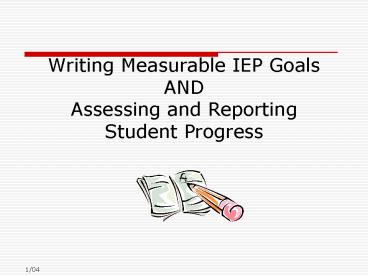Writing Measurable IEP Goals AND Assessing and Reporting Student Progress
1 / 21
Title:
Writing Measurable IEP Goals AND Assessing and Reporting Student Progress
Description:
Examples: Reading comprehension, communication, motor skills, math computation, ... reading comprehension questions. Results are recorded. Weekly Reading ... –
Number of Views:862
Avg rating:3.0/5.0
Title: Writing Measurable IEP Goals AND Assessing and Reporting Student Progress
1
Writing Measurable IEP Goals ANDAssessing and
Reporting Student Progress
2
IEP Goal Guidelines
- Annual Goals should be
- Realistically attainable in one year.
- Aligned with AZ Standards.
- Measurable.
- Understandable by student and parents.
3
Components of an Annual Goal
- Change in performance
- Examples Increase, Decrease, Improve
- Area of change
- Examples Reading comprehension,
- communication, motor skills, math computation,
- behavior, written language, etc.
- Condition
- Examples
- At the Essential level (4th grade)
- At the Functional level
- Criteria
- Examples
- As measured by Informal reading Inventory
- As measured by teacher checklist.
4
Where to begin?
5
Determine the Childs Present Level of
Performance
- Results from Stanford Nine
- Results from AIMS
- General Ed.Teacher Report
- Special Ed. Teacher Report
- Progress Toward Current Goals and Objectives
- Parent Input
- Student Input
- Informal Teacher Assessment Informal Reading
Assessment (IRI), Brigance Inventory etc. - Portfolio/Work Samples
- Grades/Report Card
6
Writing Measurable Annual Goals
Choose students areas of Need (Goals) Readin
g Study Skills Writing Math Behavior
Social Skills Communication Etc.
7
ReviewHow to Write a Goal
- Determine if appropriate to utilize the Grade
Level for developing the Goal - Must use the four components of a goal
- Identify the
- Area of change
- Change in performance
- Condition (to what level)
- Criteria
8
Goals and Objectives Based on the AZ State
Standards (using the Copper Curriculum
Framework)
- Identify the Area of Need SUBJECT (i.e. Language
Arts, Math, etc.) - Choose the STANDARD (i.e. Reading, Writing,
Listening and Speaking) - Start at grade level at which the student is
enrolled (if appropriate).
9
Measurable annual goals can be written in two
ways
- FIRST WAY
- Choose a Standard (i.e. Reading)
- Students learn and effectively apply a variety of
reading strategies for comprehending,
interpreting and evaluating a wide range of texts
including fiction, nonfiction, classic and
contemporary works. - Modify the standard to meet the needs of the
student and add the condition and the criteria. - Example
- Sam will effectively apply a variety of reading
strategies for comprehending, interpreting and
evaluating a wide range of texts at the 4th grade
level as measured by an informal inventory. - Use the accompanying standards as bench
marks/short term objectives by adding the
criteria to make them measurable.
10
Second way to write a measurable Annual Goal
- Choose a Standard
- Example
- R-E2 Use reading strategies such as making
inferences and predictions, summarizing... - Modify the standard to meet the needs of the
student and add the condition and the criteria - Example
- Shane will use reading strategies such as making
inferences, predictions, and summarizing to the
4th grade level as measured by informal
inventory. - Use the accompanying Performance Objectives as
bench marks/short term objectives by adding the
criteria to make them measurable.
11
Tips on Decision Making
- Think of the Goal and Objective Writing as a
continuum. - Start with the highest expectation.
- Modify the wording in light of the students PLP
until appropriate. - Move to a lower grade level if needed.
- Modify the wording of the lower grade level if
needed. - Draft your own objective if not in the AZ State
Standards. (i.e.articulation)
12
- Assessing IEP
- Progress
13
Reading assessment
- Informal reading inventory
- Brigance
- Qualitative Reading Inventory-II
- Authors Lauren Leslie and Joanne Caldwell
- Publisher Addison Wesley
14
How to do a weekly reading assessment
- Conduct as part of class
- Copy 1-2 pages from reading passage used in class.
- As student reads, mark teacher copy with Miscue
notations. - Ask reading comprehension questions.
- Results are recorded.
15
Weekly Reading Assessment
- Students chart own progress
- Benefits
- Instruction can be adjusted on ongoing basis.
- Students gain knowledge about his/her reading
skills. - The teacher has ongoing IEP data to report on
students quarterly progress reports.
16
What to do with results?
- Share results with student.
- Student charts results.
- Identify target skills with student.
- File assessment in student portfolio/folder.
- USE DATA FOR QUARTERLY IEP PROGRESS REPORTS.
17
Examples of charting
- See handouts!
- Design your own!
18
Writing Assessment
- Use of Rubric
- Six Trait Six Point Rubric
- Weekly assessments
- Journal writing
- Response to reading materials
- Homework assignments
19
Spelling
- Integrated into writing
- Assessment chart see handouts
20
Math Assessment
- Brigance
- Curriculum Based Assessment
- Computation
- Problem Solving
21
Math Progress Charts
- See handouts
- Design your own!
22
And the cycle continues































